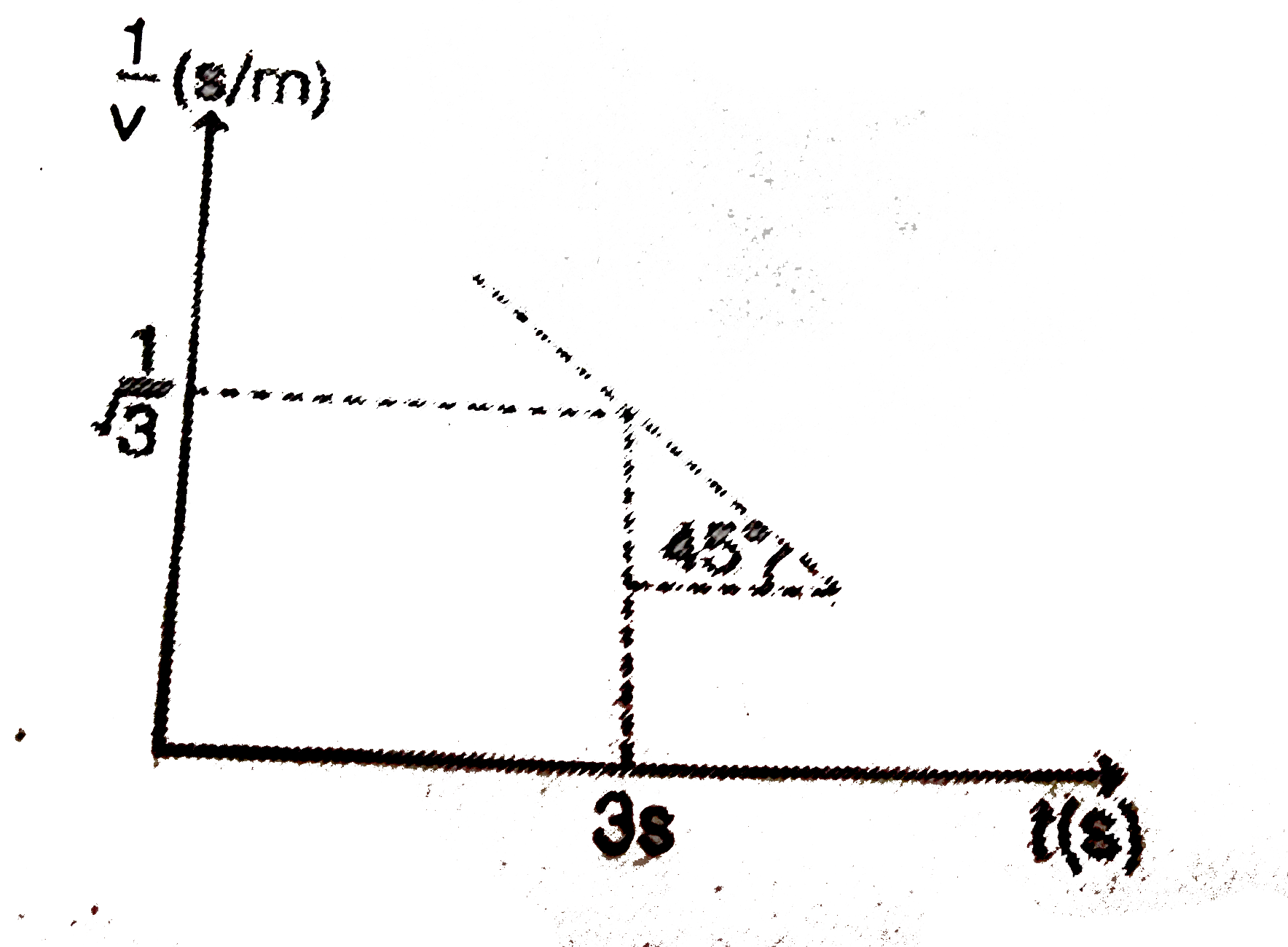The motion of a body is given by the equation dv/dt=6−3v, where v is in m//s. If the body was at rest at t=0
(i) the terminal speed is 2m/s
(ii) the magnitude of the initial acceleration is 6m/s2
(iii) The speed varies with time as v=2(1−e−3t)m/s
(iv) The speed is 1m/s, when the acceleration is half initial value
The correct Answer is:5
To solve the problem, we start with the differential equation given for the motion of the body:
dvdt=6−3v
Step 1: Rearranging and Integrating
We can rearrange the equation to separate the variables:
dv6−3v=dt
Next, we integrate both sides. The left side requires a substitution. We can rewrite it as:
∫dv6−3v=∫dt
Step 2: Performing the Integration
The left side can be integrated using the natural logarithm:
−13ln|6−3v|=t+C
Where C is the constant of integration.
Step 3: Applying Initial Conditions
At t=0, the body is at rest, so v=0:
−13ln|6−3(0)|=0+C⟹C=−13ln(6)
Substituting C back into the equation gives:
−13ln|6−3v|=t−13ln(6)
Step 4: Solving for v
Rearranging gives:
ln|6−3v|=−3t+ln(6)
Exponentiating both sides:
6−3v=6e−3t
Solving for v:
3v=6−6e−3t⟹v=2(1−e−3t)
Step 5: Finding Terminal Speed
The terminal speed occurs as t→∞:
v=2(1−e−3t)→2(1−0)=2 m/s
Step 6: Finding Initial Acceleration
To find the initial acceleration, we differentiate v:
a=dvdt=6−3v
At t=0, v=0:
a=6−3(0)=6 m/s2
Step 7: Finding Speed When Acceleration is Half
The initial acceleration is 6 m/s2, so half of that is 3 m/s2:
3=6−3v⟹3v=3⟹v=1 m/s
Summary of Results
1. Terminal speed is 2 m/s.
2. Initial acceleration is 6 m/s2.
3. Speed varies with time as v=2(1−e−3t) m/s.
4. Speed is 1 m/s when acceleration is half the initial value.
We can rearrange the equation to separate the variables:
The left side can be integrated using the natural logarithm:
At t=0, the body is at rest, so v=0:
Rearranging gives:
The terminal speed occurs as t→∞:
To find the initial acceleration, we differentiate v:
The initial acceleration is 6 m/s2, so half of that is 3 m/s2:
1. Terminal speed is 2 m/s.
2. Initial acceleration is 6 m/s2.
3. Speed varies with time as v=2(1−e−3t) m/s.
4. Speed is 1 m/s when acceleration is half the initial value.
Topper's Solved these Questions
- BOOK - ALLENCHAPTER - MOTION IN A PALNEEXERCISE - EXERCISE-0237videos
MOTION IN A PALNE
- BOOK - ALLENCHAPTER - MOTION IN A PALNEEXERCISE - EXERCISE-036videos
MOTION IN A PALNE
- BOOK - ALLENCHAPTER - KINEMATICS-2DEXERCISE - Exercise (O-2)46videos
KINEMATICS-2D
- BOOK - ALLENCHAPTER - NEWTON'S LAWS OF MOTION & FRICTIONEXERCISE - EXERCISE (JA)4videos
NEWTON'S LAWS OF MOTION & FRICTION
Similar Questions
The motion of a body is given by the equation dvdt=4−2v, where v is the speed in m/s and t in second. If the body was at rest at t = 0, then find
(i) The magnitude of initial acceleration
(ii) Speed of body as a function of timeView SolutionThe motion of a particle moving along x-axis is represented by the equation dvdt=6−3v, where v is in m/s and t is in second. If the particle is at rest at t = 0 , then
View Solution
Knowledge Check
- Question 1 - Select One
The motion of a body is given by the equation dν/dt = 6 - 3ν where ν is the speed in ms−1 and t is time in s. The body is at rest at t = 0. The speed varies with time as
Aν=(1−e−3t)Bν=2(1−e−3t)Cν=1+e−2tDν=2(1+e−2t)
A particle is moving on a circular path of radius 1 m with 2 m/s. If speed starts increasing at a rate of 2m/s2, then acceleration of particle is
View SolutionThe position of a particle is given by x=7+3t3 m and y=13+5t−9t2m, where x and y are the position coordinates, and t is the time in s. Find the speed (magnitude of the velocity) when the x component of the acceleration is 36m/s2.
View SolutionThe diagram shows the variatioin of 1/v (where v is velocity of the particle) with respect to time. At time t=3s using the details given in the graph, find the instantaneous acceleration (in m/s2)
 View Solution
View SolutionThe velocity v of a body moving along a straight line varies with time t as v=2t2e−t, where v is in m/s and t is in second. The acceleration of body is zero at t =
View SolutionA particle, initially at rest, starts moving in a straight line with an acceleration a=6t+4m/s2. The distance covered by it in 3 s is
View SolutionMotion of particle is given by equation
s=(5t3+3t2+8t+17)m
The value of acceleration of the particle at t = 2 s isView SolutionA particle is performing circular motion of radius 1 m. Its speed is v=(2t2)m/s. What will be magnitude of its acceleration at t=1s.
View Solution

